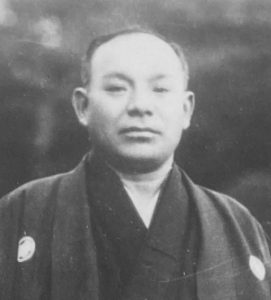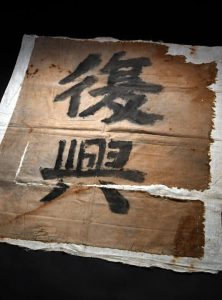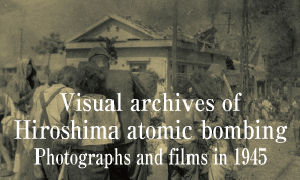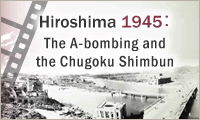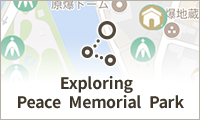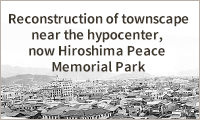Documenting Hiroshima of 1945: September 1, citizens die while longing to “rebuild”
Sep. 1, 2024
by Kyosuke Mizukawa, Senior Staff Writer
On September 1, 1945, Tomojiro Obara, 61 at the time, who ran Obara Confectionaries in the area of Yokobori-machi (in Hiroshima’s present-day Naka Ward), died at the location where he had taken refuge in what is now the city’s Nishi Ward. In the immediate aftermath of the atomic bombing, he had vowed to rebuild his factory.
His father dying shortly after his birth, Mr. Obara began working at a confectionery store as an apprentice at the age of 16. He married when he was 20 and opened his own business. He made jellies and candied beans while helping raise six sons and one daughter. Before the war, he had been exporting his products to Hawaii and other locations. He also served as head of the Hiroshima confectioners union.
On August 6, his confectionery factory and nearby home, located around 900 meters northwest of the hypocenter, were destroyed in the bombing, with Mr. Obara suffering a head wound. His sixth son, Masaharu, 19 at the time, who was polishing his bicycle in front of their home, suffered burns over his entire body and died.
On August 7, Mr. Obara returned to the site of the family home, which had been reduced to ashes, and planted a flag using cloth that had survived the fires, writing “Rebuild” on the fabric with charcoal. His third son, Yoshiro, who died in 2003 at the age of 90, was with him at the time.
Mr. Obara’s granddaughter, Kaoru Miyagawa, 66, a resident of Hiroshima’s Naka Ward, often heard stories about that time from her father, Yoshiro. “My father told me that my grandfather hoisted the flag and said, ‘I will definitely build the factory here once again.’”
After about one week, however, he became bedridden. Mr. Obara had said, “I wonder why I feel so tired,” but treatment could not save him. “The ‘Rebuild’ banner was carefully kept in the family Buddhist altar for many years,” explained Ms. Miyagawa. The surviving family members worked together to restore the factory.
The atomic bombing ruined the health of many members of the public who had set their sights on rebuilding their lives. Kinzo Kagawa, 56 at the time, who was a geta (Japanese wooden clog) craftsperson, experienced the atomic bombing at his combined home and workshop in the Hirose district (in Hiroshima’s present-day Naka Ward) and took shelter in the city’s suburbs. Not suffering serious wounds, he would ride his bicycle to pick up tools for work but ultimately died on September 1. His death certificate, indicating his cause of death to have been “uranium poisoning,” is kept at the Hiroshima Peace Memorial Museum.
(Originally published on September 1, 2024)
On September 1, 1945, Tomojiro Obara, 61 at the time, who ran Obara Confectionaries in the area of Yokobori-machi (in Hiroshima’s present-day Naka Ward), died at the location where he had taken refuge in what is now the city’s Nishi Ward. In the immediate aftermath of the atomic bombing, he had vowed to rebuild his factory.
His father dying shortly after his birth, Mr. Obara began working at a confectionery store as an apprentice at the age of 16. He married when he was 20 and opened his own business. He made jellies and candied beans while helping raise six sons and one daughter. Before the war, he had been exporting his products to Hawaii and other locations. He also served as head of the Hiroshima confectioners union.
On August 6, his confectionery factory and nearby home, located around 900 meters northwest of the hypocenter, were destroyed in the bombing, with Mr. Obara suffering a head wound. His sixth son, Masaharu, 19 at the time, who was polishing his bicycle in front of their home, suffered burns over his entire body and died.
On August 7, Mr. Obara returned to the site of the family home, which had been reduced to ashes, and planted a flag using cloth that had survived the fires, writing “Rebuild” on the fabric with charcoal. His third son, Yoshiro, who died in 2003 at the age of 90, was with him at the time.
Mr. Obara’s granddaughter, Kaoru Miyagawa, 66, a resident of Hiroshima’s Naka Ward, often heard stories about that time from her father, Yoshiro. “My father told me that my grandfather hoisted the flag and said, ‘I will definitely build the factory here once again.’”
After about one week, however, he became bedridden. Mr. Obara had said, “I wonder why I feel so tired,” but treatment could not save him. “The ‘Rebuild’ banner was carefully kept in the family Buddhist altar for many years,” explained Ms. Miyagawa. The surviving family members worked together to restore the factory.
The atomic bombing ruined the health of many members of the public who had set their sights on rebuilding their lives. Kinzo Kagawa, 56 at the time, who was a geta (Japanese wooden clog) craftsperson, experienced the atomic bombing at his combined home and workshop in the Hirose district (in Hiroshima’s present-day Naka Ward) and took shelter in the city’s suburbs. Not suffering serious wounds, he would ride his bicycle to pick up tools for work but ultimately died on September 1. His death certificate, indicating his cause of death to have been “uranium poisoning,” is kept at the Hiroshima Peace Memorial Museum.
(Originally published on September 1, 2024)

